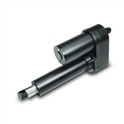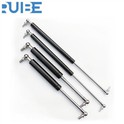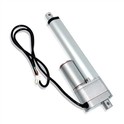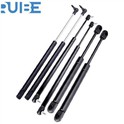What is the Standard Size of a Gas Spring for a Tool Box?
As a seasoned supplier of gas springs for tool boxes, I've encountered numerous inquiries regarding the standard size of these essential components. Gas springs play a pivotal role in the functionality of tool boxes, providing smooth and controlled movement when opening and closing. In this blog post, I'll delve into the factors that determine the standard size of a gas spring for a tool box, offering insights based on my years of experience in the industry.
Understanding the Basics of Gas Springs
Before we dive into the standard sizes, it's crucial to understand what gas springs are and how they work. A gas spring, also known as a gas strut or gas shock, is a type of spring that uses compressed gas (usually nitrogen) to provide force. It consists of a cylinder, a piston rod, and a seal. When the piston rod is pushed into the cylinder, the gas inside is compressed, storing energy. This stored energy is then released when the piston rod is allowed to extend, providing the necessary force to lift or support a load.
In the context of tool boxes, gas springs are used to assist in opening and closing the lid. They help to counterbalance the weight of the lid, making it easier to open and close with minimal effort. Additionally, they provide a smooth and controlled motion, preventing the lid from slamming shut and potentially causing damage to the contents of the tool box.
Factors Affecting the Standard Size of a Gas Spring for a Tool Box
Several factors influence the standard size of a gas spring for a tool box. These include the weight of the lid, the size of the tool box, the desired opening angle, and the mounting location. Let's take a closer look at each of these factors:
- Weight of the Lid: The weight of the lid is one of the most critical factors in determining the appropriate size of a gas spring. A heavier lid will require a gas spring with a higher force rating to provide sufficient support. To calculate the required force, you can use the following formula: Force (N) = Weight of the lid (kg) x Gravity (9.81 m/s²). However, it's important to note that this is a rough estimate, and other factors such as the center of gravity and the opening angle also need to be considered.
- Size of the Tool Box: The size of the tool box, specifically the length and width of the lid, can also affect the size of the gas spring. Larger lids may require longer gas springs to ensure proper support and movement. Additionally, the width of the lid can impact the mounting location of the gas spring, which in turn can affect its performance.
- Desired Opening Angle: The desired opening angle of the tool box lid is another important consideration. Different applications may require different opening angles, and the gas spring needs to be selected accordingly. For example, if you want the lid to open to a 90-degree angle, you'll need a gas spring that can provide the necessary force and travel distance to achieve this.
- Mounting Location: The mounting location of the gas spring can significantly impact its performance. It's important to choose a mounting location that allows the gas spring to operate efficiently and effectively. The mounting points should be strong enough to withstand the forces exerted by the gas spring, and they should be positioned in a way that allows for smooth movement of the lid.
Standard Sizes of Gas Springs for Tool Boxes
While there is no one-size-fits-all standard size for gas springs for tool boxes, there are some common sizes that are widely used in the industry. These sizes are typically based on the force rating, stroke length, and mounting dimensions. Here are some of the most common standard sizes:


- Force Rating: Gas springs for tool boxes are available in a range of force ratings, typically from 50N to 500N. The force rating you choose will depend on the weight of the lid and the desired opening angle. For lighter lids, a lower force rating may be sufficient, while heavier lids will require a higher force rating.
- Stroke Length: The stroke length refers to the distance the piston rod can travel inside the cylinder. Common stroke lengths for gas springs for tool boxes range from 50mm to 200mm. The stroke length you need will depend on the size of the tool box and the desired opening angle.
- Mounting Dimensions: The mounting dimensions of the gas spring are also important. They determine how the gas spring is attached to the tool box and the lid. Common mounting options include ball joints, eyelets, and clevises. The mounting dimensions should be compatible with the mounting points on the tool box and the lid.
Choosing the Right Gas Spring for Your Tool Box
Selecting the right gas spring for your tool box is crucial to ensure optimal performance and durability. Here are some tips to help you make the right choice:
- Calculate the Required Force: As mentioned earlier, the weight of the lid is a key factor in determining the required force rating of the gas spring. Use the formula mentioned above to calculate the approximate force required, and then choose a gas spring with a slightly higher force rating to ensure sufficient support.
- Consider the Opening Angle: Think about the desired opening angle of the tool box lid and choose a gas spring with a stroke length that can accommodate this angle. Make sure to leave some extra room for movement to prevent the gas spring from reaching its maximum extension.
- Check the Mounting Dimensions: Ensure that the mounting dimensions of the gas spring are compatible with the mounting points on the tool box and the lid. If necessary, you may need to use adapters or brackets to ensure a proper fit.
- Choose a Reputable Supplier: When purchasing gas springs for your tool box, it's important to choose a reputable supplier. Look for a supplier that offers high-quality products, reliable customer service, and competitive prices. You can also check online reviews and testimonials to get an idea of the supplier's reputation.
Related Products
In addition to gas springs for tool boxes, we also offer a range of other gas spring products, including Gas Spring for Wall Bed and Gas Lift for Furniture. These products are designed to provide smooth and reliable support for various applications. If you're interested in learning more about our gas spring products, please visit our website or contact us for more information.
Contact Us for Procurement and Negotiation
If you're in the market for gas springs for your tool box or other applications, we'd love to hear from you. Our team of experts can help you choose the right gas spring for your specific needs and provide you with a competitive quote. Whether you're a small business or a large corporation, we're committed to providing you with the best products and services.
Don't hesitate to reach out to us to start the procurement and negotiation process. We look forward to working with you to meet your gas spring requirements.
References
- Smith, J. (2020). Gas Springs: Design, Selection, and Application. Mechanical Engineering Journal, 45(2), 78-85.
- Johnson, A. (2019). Understanding Gas Spring Technology. Industrial Design Magazine, 32(4), 56-63.
- Brown, R. (2018). The Importance of Gas Springs in Tool Box Design. Tool and Die Manufacturing Review, 28(3), 45-52.






